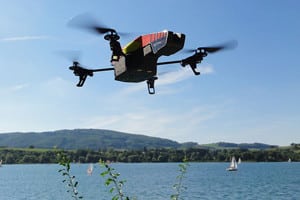Now a solution to bring that intrusive drone down
Last Updated on June 29, 2024 by Datatoys

Authorities around the world have tried different measures for this. The Dutch police, for instance, has trained eagles to tackle intrusive drones. Other measures include shooting a net to capture the drone, or even the conventional firearms to shoot the drone down.
However, none of these measures are perfect. Using eagles is not agreeable to animal rights activists, nets are not viable in the long distance and firearms come with their own challenges.
Now, a Taiwanese startup has come up with a solution that can bring a drone down or send it back to its spot of origin. DronesVision’s HiGH + MiGHTY SKYNET looks like an oversized rifle with a viewfinder and a trigger to activate it. It is light at 5.7kg and works on lithium ion battery that has to be carried separately in a backpack.
How does it work?
Consumer drones mainly use two bands in while in operation. One is the GPS/GLONASS for satellite position at 1.45-1.65GHz and the other is the remote control uplink and video transmission downlink, both of which use 2.4 GHz band.
“Our product HiGH + MiGHTY SKYNET anti-drone system is designed to jam/block these two bands when drones are flying into unauthorized areas,” said Kason Shih, Founder and CEO of DronesVision. “HiGH + MiGHTY SKYNET can block GPS navigation positioning, force rogue drones fly back to original take-off points, or to land onto the ground where they hovered.”
The solution can work in three modes. In the first mode, it can cut off the global positioning system alone, causing the drone to drift in the air, making it harder to control. Usually, when this happens, the owner gets nervous and stops flying around. In the second mode it can jam the remote transmission link, cutting off the video connectivity, and it will send the drone back to its owner, allowing authorities to track down the culprit. In the third mode, the solution can force the drone to land on the spot where it hovered and got jammed, enabling authorities to access the footages it has recorded.
The target market
SKYNET can be useful in a range of situations, but currently, the company is targeting government, critical infrastructure and other large-scale deployments. It sells mainly to systems integrators and arms dealers.
“At the moment, our target customers are government-related units such as military, police and law enforcement, fire department, power plants, prisons, airports,” Shih said. “In the near future, it might be deployed to protect stadiums or sports events, amusement parks, national parks.
Outlook
The drone market is expected to witness significant growth in the coming years. According to a report from MarketsandMarkets, the global UAV market for commercial application is expected to reach US$5.59 billion by 2020, growing at a CAGR of 32.22 percent between 2015 and 2020.
With such growth, the concerns associated with it could also increase, and hence there could be a strong market for a solution like SKYNET in the coming years. DronesVision is looking to capitalize on this and is currently working on a second solution called Dronedar that would integrate a radar-based drone detection system with the anti-drone facility.
This article originally appeared on August 23, 2016 on www.asmag.com, written by Prasanth Aby Thomas.
Source: http://www.asmag.com/showpost/21033.aspx

Leave a Reply
Want to join the discussion?Feel free to contribute!